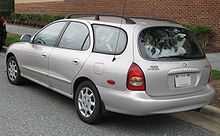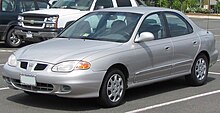Second generation (J2, J3; 1995–2000)
 | |
| Also called | Hyundai Avante (South Korea) Hyundai Avante Touring (Wagon in South Korea) Hyundai Lantra Bimantara Cakra Bimantara Nenggala |
|---|---|
| Production | 1995–2000 |
| Model year(s) | 1996–2000 |
| Assembly | Ulsan, Korea Gaborone, Botswana (TMBC)[3] |
| Body style(s) | 5-door station wagon 4-door sedan |
| Engine(s) | 1.5/1.6/1.8/2.0L 89/112/130/140 hp I4 (104 kW) |
| Transmission(s) | 5-speed manual 4-speed automatic |
| Wheelbase | 2,550 mm (100.4 in) |
| Length | 1995–1998 Sedan:4,420 mm (174.0 in) 1995–1998 Wagon:4,450 mm (175.2 in) 1998–2000 Sedan:4,450 mm (175.2 in) 1998–2000 Wagon:4,515 mm (177.8 in) |
| Width | 1995–1998:1,700 mm (66.9 in) 1998–2000:1,735 mm (68.3 in) |
| Height | 1,395 mm (54.9 in) 1998–2000 Wagon:1,460 mm (57.5 in) |
Between 1996 and 1998, the Elantra was marketed as the Bimantara Nenggala (1.8 litre petrol) in Indonesia. (The Cakra (1.5 litre petrol) was based on the Accent (X3).)
At launch, a 1.5-litre Alpha SOHC (107 hp) I4 engine and 1.8-litre Beta DOHC (128 hp) gasoline I4 engine were available on the domestic market. Later, a 1.5-litre lean-burn (98 hp) gasoline engine based on Alpha DOHC engine was added. A mid-life facelift arrived for 1999. The Philippine version, as well as in some European markets, had the 1.6 (1599 cc) Beta, DOHC (G4GR) which produced 116 hp (87 kW) (in some European markets 66 kW (90 PS; 89 hp)).
In Europe, 1996-1997 sedan models had carried a silver Mercury-type grille, whereas station wagon models had carried the same grille as the North American sedan and wagon models.
In Australia, the station wagon was called the Lantra Sportswagon and was a popular model of Hyundai.
A 2.0-litre engine option became available near the end of its production run. In Australia the GLS model was an upgrade on the GL model, and supplies 2 litre engine, velour trim, softer cloth seats, and Hyundai's version of mag wheels. Also the GLS had matching paint on rear number plate light holder and side mirrors.



ليست هناك تعليقات:
إرسال تعليق